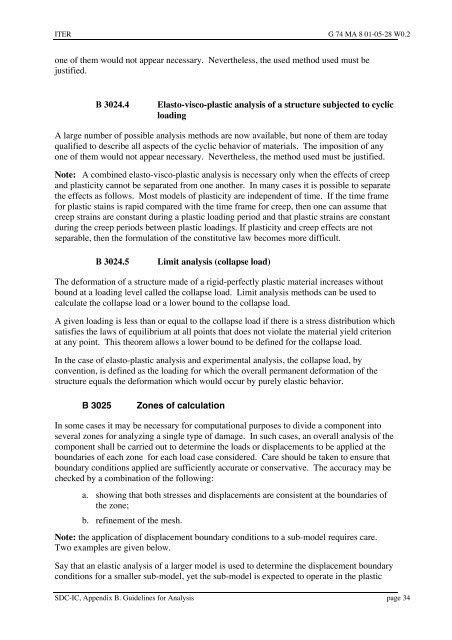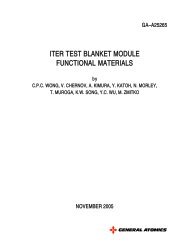iter structural design criteria for in-vessel components (sdc-ic)
iter structural design criteria for in-vessel components (sdc-ic)
iter structural design criteria for in-vessel components (sdc-ic)
You also want an ePaper? Increase the reach of your titles
YUMPU automatically turns print PDFs into web optimized ePapers that Google loves.
ITER G 74 MA 8 01-05-28 W0.2<br />
one of them would not appear necessary. Nevertheless, the used method used must be<br />
justified.<br />
B 3024.4 Elasto-visco-plast<strong>ic</strong> analysis of a structure subjected to cycl<strong>ic</strong><br />
load<strong>in</strong>g<br />
A large number of possible analysis methods are now available, but none of them are today<br />
qualified to describe all aspects of the cycl<strong>ic</strong> behavior of materials. The imposition of any<br />
one of them would not appear necessary. Nevertheless, the method used must be justified.<br />
Note: A comb<strong>in</strong>ed elasto-visco-plast<strong>ic</strong> analysis is necessary only when the effects of creep<br />
and plast<strong>ic</strong>ity cannot be separated from one another. In many cases it is possible to separate<br />
the effects as follows. Most models of plast<strong>ic</strong>ity are <strong>in</strong>dependent of time. If the time frame<br />
<strong>for</strong> plast<strong>ic</strong> sta<strong>in</strong>s is rapid compared with the time frame <strong>for</strong> creep, then one can assume that<br />
creep stra<strong>in</strong>s are constant dur<strong>in</strong>g a plast<strong>ic</strong> load<strong>in</strong>g period and that plast<strong>ic</strong> stra<strong>in</strong>s are constant<br />
dur<strong>in</strong>g the creep periods between plast<strong>ic</strong> load<strong>in</strong>gs. If plast<strong>ic</strong>ity and creep effects are not<br />
separable, then the <strong>for</strong>mulation of the constitutive law becomes more diff<strong>ic</strong>ult.<br />
BÊ3024.5 Limit analysis (collapse load)<br />
The de<strong>for</strong>mation of a structure made of a rigid-perfectly plast<strong>ic</strong> material <strong>in</strong>creases without<br />
bound at a load<strong>in</strong>g level called the collapse load. Limit analysis methods can be used to<br />
calculate the collapse load or a lower bound to the collapse load.<br />
A given load<strong>in</strong>g is less than or equal to the collapse load if there is a stress distribution wh<strong>ic</strong>h<br />
satisfies the laws of equilibrium at all po<strong>in</strong>ts that does not violate the material yield cr<strong>iter</strong>ion<br />
at any po<strong>in</strong>t. This theorem allows a lower bound to be def<strong>in</strong>ed <strong>for</strong> the collapse load.<br />
In the case of elasto-plast<strong>ic</strong> analysis and experimental analysis, the collapse load, by<br />
convention, is def<strong>in</strong>ed as the load<strong>in</strong>g <strong>for</strong> wh<strong>ic</strong>h the overall permanent de<strong>for</strong>mation of the<br />
structure equals the de<strong>for</strong>mation wh<strong>ic</strong>h would occur by purely elast<strong>ic</strong> behavior.<br />
BÊ3025 Zones of calculation<br />
In some cases it may be necessary <strong>for</strong> computational purposes to divide a component <strong>in</strong>to<br />
several zones <strong>for</strong> analyz<strong>in</strong>g a s<strong>in</strong>gle type of damage. In such cases, an overall analysis of the<br />
component shall be carried out to determ<strong>in</strong>e the loads or displacements to be applied at the<br />
boundaries of each zone <strong>for</strong> each load case considered. Care should be taken to ensure that<br />
boundary conditions applied are suff<strong>ic</strong>iently accurate or conservative. The accuracy may be<br />
checked by a comb<strong>in</strong>ation of the follow<strong>in</strong>g:<br />
a. show<strong>in</strong>g that both stresses and displacements are consistent at the boundaries of<br />
the zone;<br />
b. ref<strong>in</strong>ement of the mesh.<br />
Note: the appl<strong>ic</strong>ation of displacement boundary conditions to a sub-model requires care.<br />
Two examples are given below.<br />
Say that an elast<strong>ic</strong> analysis of a larger model is used to determ<strong>in</strong>e the displacement boundary<br />
conditions <strong>for</strong> a smaller sub-model, yet the sub-model is expected to operate <strong>in</strong> the plast<strong>ic</strong><br />
SDC-IC, Appendix B. Guidel<strong>in</strong>es <strong>for</strong> Analysis page 34




